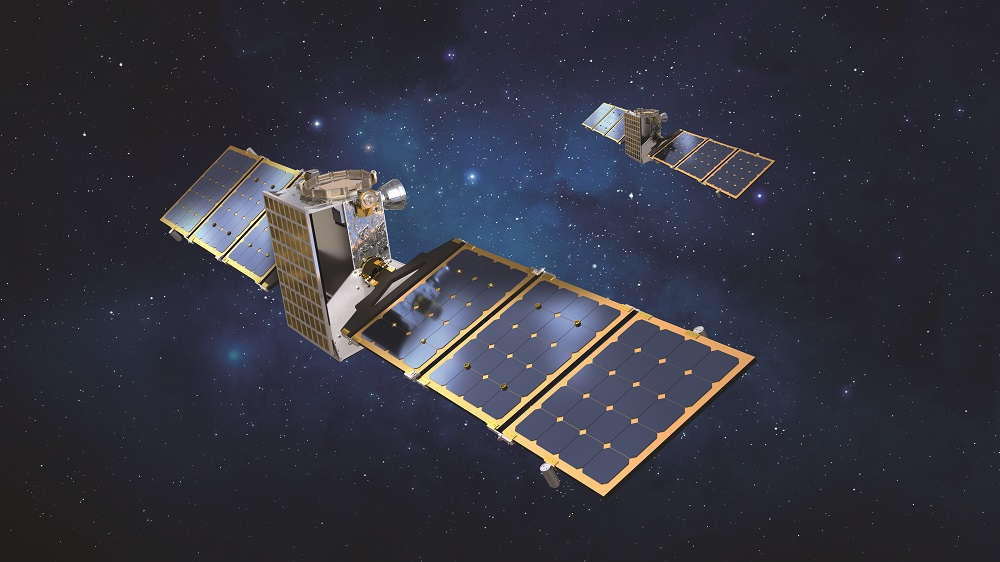
WASHINGTON — A NASA asteroid smallsat mission that lost its original ride to space is considering alternative missions while also accommodating performance issues with its propulsion system.
Janus was originally designed to fly two smallsats that would then fly by separate binary asteroid missions. The mission, part of a NASA planetary smallsat program called Small Innovative Missions for Planetary Exploration, or SIMPLEx, was set to launch as a secondary payload on the Falcon Heavy launch of Psyche in 2022.
However, the delay of Psyche’s launch to October 2023 meant that Janus could not fly its original trajectory to reach its original targets or others of scientific interest. NASA announced Nov. 18 that it had removed Janus from the Psyche launch to allow the mission to explore possible alternative missions.
At a Jan. 25 meeting of NASA’s Small Bodies Assessment Group, Dan Scheeres, principal investigator for Janus at the University of Colorado, said Psyche’s new trajectory with the 2023 launch was unsuitable for Janus. The spacecraft would end up going well into the main asteroid belt, sharply reducing the power available from its solar arrays.
“This new launch would send our spacecraft beyond their operating envelopes in a matter of months,” he said. “Within five months, we wouldn’t have enough power to do anything. So, basically, we’d be a brick in less than five months.”
When that became clear, the mission asked NASA to be demanifested from the Psyche mission, which he said NASA approved on Nov. 17. “Suddenly, we don’t have a launch,” he said. “Suddenly, everything we were designed to do is not nominally achievable.”
The spacecraft, which Scheeres described as being nearly complete and tested, are being placed in storage while the project team considers alternative missions. One intriguing possibility is to send one or both Janus spacecraft to Apophis before that near Earth asteroid makes a close approach to the Earth in April 2029. That asteroid is also the target of the extended mission for OSIRIS-REx, which will fly by Earth after returning samples from the asteroid Bennu in September, allowing it to rendezvous with Apophis shortly after the asteroid goes by Earth.
He said NASA appears interested in that alternative mission, and the mission is looking for potential rideshare launch opportunities that would enable it. Janus could launch as late as early 2028 and arrive at Apophis before its April 2029 Earth flyby.
The mission is also dealing with an issue with the propulsion system used on the spacecraft. In presentations to NASA’s Planetary Science Advisory Committee and at a town hall session during the Fall Meeting of the American Geophysical Union (AGU) in December, Lori Glaze, NASA planetary science division director, mentioned unspecified problems with the propulsion system that had not previously been disclosed.
She suggested those issues could have prevented Janus from carrying out its original mission or restrict alternative missions. “The certainty with which we could execute the mission is in question,” she said at the AGU town hall.
“The risk posture for SIMPLEx missions like Janus is that they are high-risk and low-cost, with the intention of proving out new technologies. For smallsats in particular, there are few flight-proven propulsion systems currently available,” Lockheed Martin spokesperson Lauren Duda told SpaceNews. “In Janus’ case, the full performance envelope of Janus’ novel electric propulsion system could not be verified in ground testing.”
Scheeres said that Janus changed its propulsion system between proposal submission and selection when it became clear to the team that the original vendor could not deliver. The project switched vendors and passed a series of reviews, including a critical design review, with the new thruster. He did not identify the companies that provided either the original propulsion system or the new one.
Those reviews did not address all the concerns about the new thruster, and the project developed a test program for it that featured a goal of firing the thruster for 2,000 hours in a test chamber. The test stopped after 1,350 hours because of what he described as “specific issues with the test setup and operation” and not necessarily because of a problem with the thruster itself.
He said that NASA instructed the Janus project that any alternative missions for Janus will have to address the potentially limited lifetime of the thruster. Potential trajectories for an Apophis flyby include those that fit within the thruster’s tested lifetime.
Glaze said in December that she instructed the Janus team to use the funding left from its original award to look at alternative missions, but it was unclear how much NASA would be willing to spend on a different mission. The SIMPLEx awards NASA made in 2019 for Janus and two other smallsats, EscaPADE and Lunar Trailblazer, had cost caps of $55 million, although Lunar Trailblazer’s cost has grown by more than 30% since then because of changes in launch vehicles and other spacecraft issues.
Scheeres, despite the difficulties, remained optimistic about launching Janus on an alternative mission. “We’re not dead yet,” he said.
"original" - Google News
January 27, 2023 at 07:01PM
https://ift.tt/6xCSG3u
Janus considering alternative missions after losing original ride - SpaceNews
"original" - Google News
https://ift.tt/GtoqCB1
https://ift.tt/dm3EOyV
Bagikan Berita Ini














0 Response to "Janus considering alternative missions after losing original ride - SpaceNews"
Post a Comment